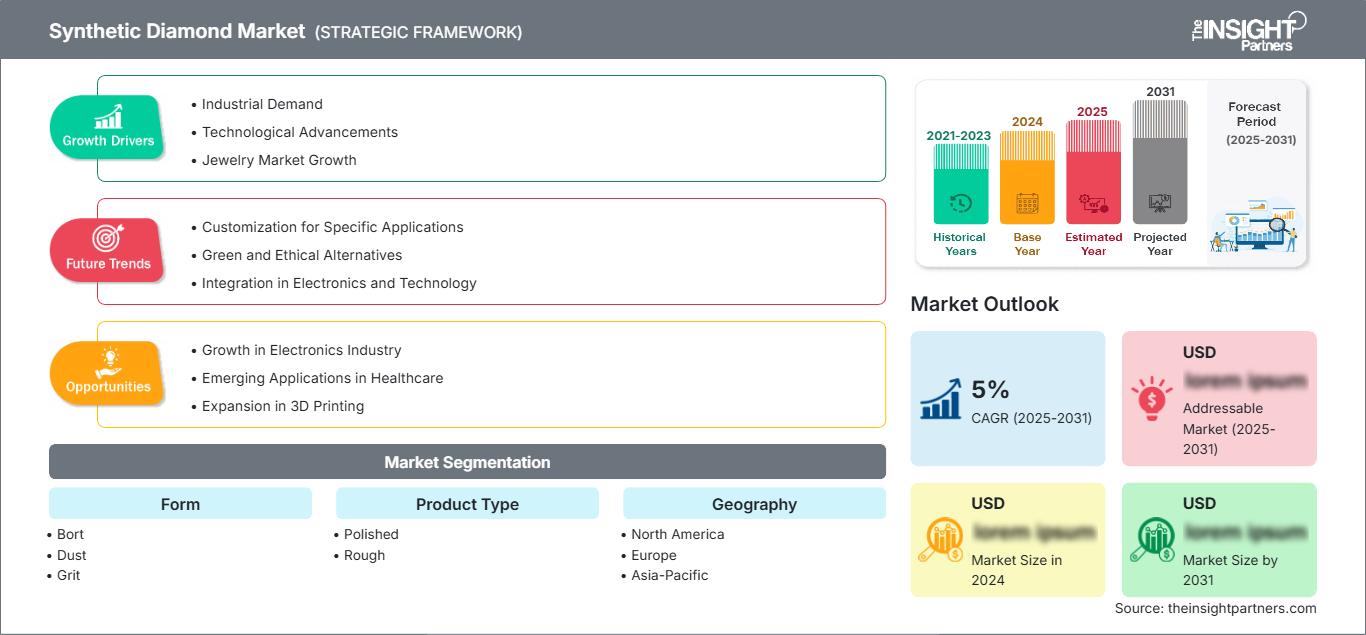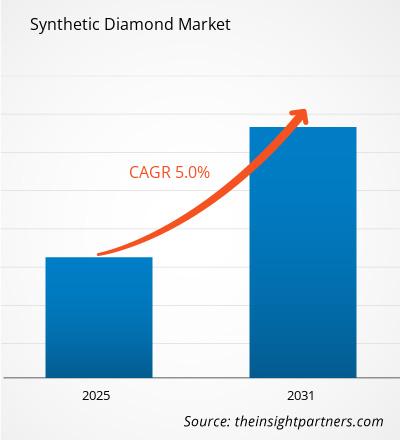Si prevede che il mercato dei diamanti sintetici registrerà un CAGR del 5% dal 2025 al 2031, con una dimensione del mercato in espansione da XX milioni di dollari nel 2024 a XX milioni di dollari entro il 2031.
Il rapporto è segmentato per tipologia (diamante sintetico, polvere, graniglia, polvere e pietre) e tipologia di prodotto (lucidato e grezzo). Il rapporto presenta inoltre analisi basate sull'applicazione (gioielleria, dissipatori di calore, laser e raggi X, utensili per lavorazione e taglio, macchinari chirurgici, trattamento delle acque, calcolo quantistico, ottica, sensori e scansione, medicina e altri). L'analisi globale è ulteriormente suddivisa a livello regionale e per i principali paesi. Le dimensioni e le previsioni del mercato a livello globale, regionale e nazionale per tutti i principali segmenti di mercato sono trattate nell'ambito di applicazione. Il rapporto fornisce il valore in USD per l'analisi e i segmenti sopra indicati. Il rapporto fornisce statistiche chiave sullo stato del mercato dei principali attori e offre tendenze e opportunità di mercato.
Scopo del rapporto
Il rapporto "Sintetic Diamond Market" di The Insight Partners mira a descrivere il panorama attuale e la crescita futura, i principali fattori trainanti, le sfide e le opportunità. Ciò fornirà spunti a vari stakeholder aziendali, come:
- Fornitori/Produttori di tecnologia: per comprendere le dinamiche di mercato in evoluzione e conoscere le potenziali opportunità di crescita, consentendo loro di prendere decisioni strategiche informate.
- Investitori: per condurre un'analisi completa delle tendenze in merito al tasso di crescita del mercato, alle proiezioni finanziarie di mercato e alle opportunità esistenti lungo la catena del valore.
- Enti di regolamentazione: per regolamentare le politiche e le attività di controllo sul mercato con l'obiettivo di ridurre al minimo gli abusi, preservare la fiducia degli investitori e sostenere l'integrità e la stabilità del mercato.
Forma di segmentazione del mercato dei diamanti sintetici
- Bort
- Polvere
- Grana
- Polvere
- Pietre
Tipo di prodotto
- Lucidato
- Grezzo
Potrai personalizzare gratuitamente qualsiasi rapporto, comprese parti di questo rapporto, o analisi a livello di paese, pacchetto dati Excel, oltre a usufruire di grandi offerte e sconti per start-up e università
Mercato dei diamanti sintetici: Approfondimenti strategici

-
Ottieni le principali tendenze chiave del mercato di questo rapporto.Questo campione GRATUITO includerà l'analisi dei dati, che vanno dalle tendenze di mercato alle stime e alle previsioni.
Fattori della crescita del mercato dei diamanti sintetici
- Domanda industriale: i diamanti sintetici sono sempre più utilizzati in applicazioni industriali come taglio, molatura e foratura grazie alla loro durezza e resistenza all'usura. La crescente domanda di lavorazioni meccaniche e manifatturiere di precisione in settori come quello automobilistico, aerospaziale e minerario è un fattore determinante per il mercato dei diamanti sintetici.
- Progressi tecnologici: i progressi nei metodi di produzione dei diamanti sintetici, come l'alta pressione e alta temperatura (HPHT) e la deposizione chimica da vapore (CVD), hanno reso la produzione più efficiente ed economica. Questi miglioramenti stanno ampliando il potenziale del mercato, rendendo i diamanti sintetici più accessibili per un'ampia gamma di applicazioni.
- Crescita del mercato della gioielleria: la crescente popolarità di alternative etiche e sostenibili nel settore della gioielleria sta stimolando la domanda di diamanti sintetici. La preferenza dei consumatori per diamanti conflict-free, accessibili ed eco-compatibili stimola la crescita del mercato, rendendo i diamanti sintetici una scelta interessante per i marchi di gioielleria moderni.
Tendenze future del mercato dei diamanti sintetici
- Personalizzazione per applicazioni specifiche: con la crescente popolarità dei diamanti sintetici, si sta diffondendo la tendenza a creare diamanti su misura per applicazioni specifiche. Ad esempio, i diamanti vengono personalizzati per l'uso nei semiconduttori, nell'elettronica e nella produzione avanzata grazie alla loro conduttività termica e alle proprietà elettriche uniche, stimolando l'innovazione in diversi settori.
- Alternative ecologiche ed etiche: la crescente preferenza per prodotti ecocompatibili e di provenienza etica è una tendenza importante nel mercato dei diamanti sintetici. Questi diamanti sono percepiti come un'alternativa sostenibile ai diamanti estratti, attraendo i consumatori attenti all'ambiente e le industrie che cercano di ridurre la propria impronta di carbonio.
- Integrazione in elettronica e tecnologia: l'uso di diamanti sintetici nell'elettronica, in particolare nei semiconduttori ad alte prestazioni e nei dissipatori di calore, è in aumento. La loro eccezionale conduttività termica e durezza li rendono ideali per la gestione del calore nei dispositivi high-tech, trainando la domanda nei settori in crescita dell'elettronica e della tecnologia.
Opportunità di mercato per i diamanti sintetici
- Crescita nel settore elettronico: il settore elettronico offre significative opportunità per i diamanti sintetici, in particolare nello sviluppo di semiconduttori ad alte prestazioni e sistemi di gestione del calore. Con la crescente domanda di dispositivi elettronici efficienti e potenti, i diamanti sintetici si posizionano come materiali essenziali nell'elettronica di nuova generazione.
- Applicazioni emergenti in ambito sanitario: il crescente interesse per i diamanti sintetici per applicazioni mediche, come strumenti chirurgici, apparecchiature di imaging e sistemi di somministrazione di farmaci, offre nuove opportunità di mercato. La loro biocompatibilità, precisione e durata stanno guidando l'esplorazione di innovazioni sanitarie che potrebbero migliorare trattamenti e dispositivi medici.
- Espansione nella stampa 3D: i diamanti sintetici stanno trovando un utilizzo crescente nelle tecnologie di stampa 3D, in particolare per applicazioni ad alta precisione. L'ascesa della produzione additiva in settori come quello aerospaziale, automobilistico e sanitario offre ai produttori di diamanti sintetici l'opportunità di fornire materiali specializzati per la stampa 3D di parti e componenti ad alte prestazioni.
Approfondimenti regionali sul mercato dei diamanti sintetici
Le tendenze regionali e i fattori che influenzano il mercato dei diamanti sintetici durante il periodo di previsione sono stati ampiamente spiegati dagli analisti di The Insight Partners. Questa sezione illustra anche i segmenti e la geografia del mercato dei diamanti sintetici in Nord America, Europa, Asia-Pacifico, Medio Oriente e Africa, America meridionale e centrale.
Ambito del rapporto sul mercato dei diamanti sintetici
| Attributo del rapporto | Dettagli |
|---|---|
| Dimensioni del mercato in 2024 | US$ XX million |
| Dimensioni del mercato per 2031 | US$ XX Million |
| CAGR globale (2025 - 2031) | 5% |
| Dati storici | 2021-2023 |
| Periodo di previsione | 2025-2031 |
| Segmenti coperti |
By Forma
|
| Regioni e paesi coperti |
Nord America
|
| Leader di mercato e profili aziendali chiave |
|
Densità degli operatori del mercato dei diamanti sintetici: comprendere il suo impatto sulle dinamiche aziendali
Il mercato dei diamanti sintetici è in rapida crescita, trainato dalla crescente domanda da parte degli utenti finali, dovuta a fattori quali l'evoluzione delle preferenze dei consumatori, i progressi tecnologici e una maggiore consapevolezza dei benefici del prodotto. Con l'aumento della domanda, le aziende stanno ampliando la propria offerta, innovando per soddisfare le esigenze dei consumatori e sfruttando le tendenze emergenti, alimentando ulteriormente la crescita del mercato.

- Ottieni il Mercato dei diamanti sintetici Panoramica dei principali attori chiave
Punti di forza
- Copertura completa: il rapporto analizza in modo esaustivo prodotti, servizi, tipologie e utenti finali del mercato dei diamanti sintetici, offrendo una panoramica olistica.
- Analisi degli esperti: il rapporto è redatto sulla base della conoscenza approfondita di esperti e analisti del settore.
- Informazioni aggiornate: il rapporto garantisce la pertinenza aziendale grazie alla copertura di informazioni e dati recenti.
- Opzioni di personalizzazione: questo rapporto può essere personalizzato per soddisfare le esigenze specifiche del cliente e adattarsi in modo appropriato alle strategie aziendali.
Il rapporto di ricerca sul mercato dei diamanti sintetici può quindi contribuire a guidare il percorso di decodificazione e comprensione dello scenario del settore e delle prospettive di crescita. Sebbene possano esserci alcune valide preoccupazioni, i vantaggi complessivi di questo rapporto tendono a superare gli svantaggi.
- Analisi storica (2 anni), anno base, previsione (7 anni) con CAGR
- Analisi PEST e SWOT
- Valore/volume delle dimensioni del mercato - Globale, Regionale, Nazionale
- Industria e panorama competitivo
- Set di dati Excel
Report recenti
Testimonianze
Motivo dell'acquisto
- Processo decisionale informato
- Comprensione delle dinamiche di mercato
- Analisi competitiva
- Analisi dei clienti
- Previsioni di mercato
- Mitigazione del rischio
- Pianificazione strategica
- Giustificazione degli investimenti
- Identificazione dei mercati emergenti
- Miglioramento delle strategie di marketing
- Aumento dell'efficienza operativa
- Allineamento alle tendenze normative






















 Ottieni un campione gratuito per - Mercato dei diamanti sintetici
Ottieni un campione gratuito per - Mercato dei diamanti sintetici